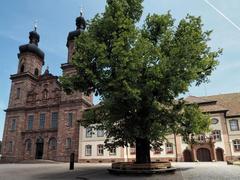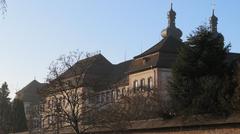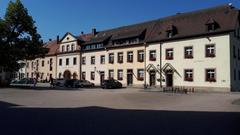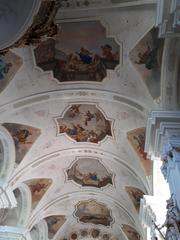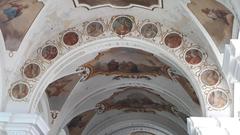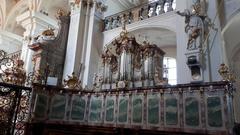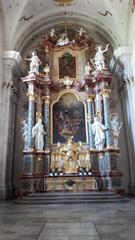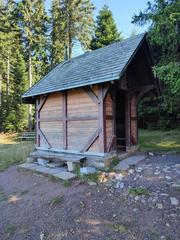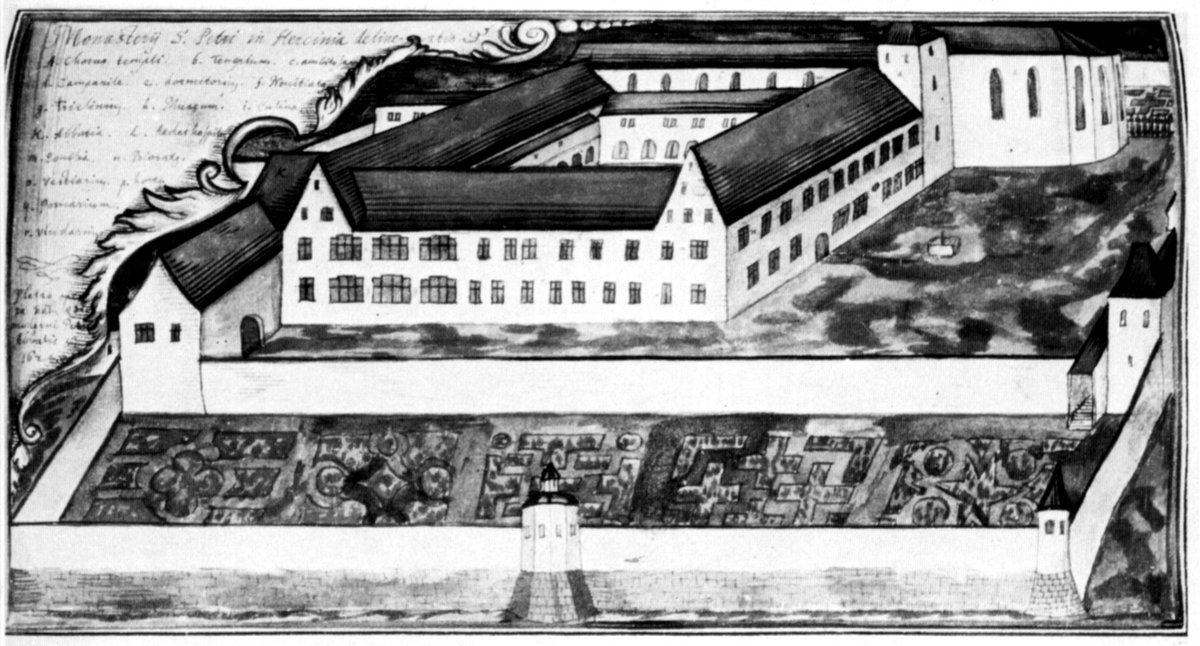
Abbey of Saint Peter in the Black Forest: Visiting Hours, Tickets, and Travel Guide
Date: 14/06/2025
Introduction
Set amid the lush landscapes of Germany’s Black Forest, the Abbey of Saint Peter (St. Peter im Schwarzwald) stands as a testament to centuries of religious, artistic, and architectural achievement. Founded in the late 11th century by Duke Berthold II of Zähringen, this Benedictine abbey has evolved from its medieval origins into one of southern Germany’s most celebrated Baroque landmarks. Renowned for its twin onion-domed towers, elaborate frescoes, and an exquisitely decorated rococo library, the abbey is a focal point for spiritual reflection, cultural exploration, and regional identity. Today, the Abbey of Saint Peter welcomes pilgrims, history enthusiasts, and travelers, offering a rich experience in both cultural heritage and the natural beauty of the Black Forest (SpottingHistory; Around the World with Liz; Black Forest Travel).
This detailed guide provides everything you need to plan your visit, including historical background, architectural highlights, visiting hours, ticketing, accessibility, and practical travel tips.
Table of Contents
- Historical Overview
- Architectural and Artistic Highlights
- Spiritual and Cultural Significance
- Visitor Information
- Events, Festivals, and Local Traditions
- Visitor Experience and Practical Tips
- Frequently Asked Questions (FAQ)
- Visuals and Additional Resources
- Plan Your Visit
1. Historical Overview
Founded in 1093 by Duke Berthold II of Zähringen, the Abbey of Saint Peter was established as both a Benedictine monastery and the Zähringen family’s burial site (SpottingHistory). Despite enduring fires, wars, and secularization, the abbey remained a vital religious and cultural institution, shaping the development of southwestern Germany.
The abbey’s medieval origins are evident in its role as a spiritual and intellectual center, with a scriptorium and writing school that contributed to the spread of literacy and scholarship. After a major fire in the 17th century, St. Peter’s was rebuilt in the Baroque style, culminating in the early 18th-century complex that stands today, featuring the work of architect Peter Thumb and artists like Franz Joseph Spiegler and Joseph Anton Feuchtmayer (Virtual Library of Saint Peter).
Following the secularization of 1806, monastic life ceased, but the abbey continued to serve as a parish church, cultural venue, and symbol of the region’s enduring heritage.
2. Architectural and Artistic Highlights
Baroque Abbey Church
The current abbey church, completed in 1727, exemplifies southern German Baroque architecture. Its pastel-colored twin towers, capped with distinctive onion domes, dominate the village skyline. The church’s façade features dynamic pilasters and statues, while the interior boasts luminous arched windows, intricate stucco, gilded altars, and a high altar by Johann Christian Wentzinger.
Interior Frescoes and Sculptural Masterpieces
The nave’s ceiling is adorned with 55 frescoes by Franz Joseph Spiegler, depicting pivotal moments from Saint Peter’s life and allegories of faith, hope, and charity. Elaborate stuccowork and polychrome marble details, along with sculptures by Joseph Anton Feuchtmayer, create a vivid and emotive atmosphere (Around the World with Liz).
Rococo Library and Monastic Complex
The rococo library, designed by Peter Thumb, is a highlight of the abbey, featuring ornate woodwork, ceiling paintings, and a historic collection of rare books. The monastic complex includes cloisters, refectories, and guesthouses, some of which have been repurposed as a parish center, museum, and accommodations.
3. Spiritual and Cultural Significance
From its foundation, the Abbey of Saint Peter has been a center of Benedictine monasticism, embodying the motto “Ora et Labora” (Pray and Work). The abbey’s direct subordination to the papacy and its Zähringen connections elevated its status, while its scriptorium and library made it a hub for learning.
Today, the church remains active, hosting Catholic services, concerts, and community events. The abbey’s archives, containing documents from the 8th to 20th centuries, are invaluable resources for historians (Wikipedia).
4. Visitor Information
Visiting Hours
-
Church and Courtyard:
- Summer: 9:00 AM – 6:00 PM
- Winter: 10:00 AM – 5:00 PM
- Closed on Mondays and during certain holidays; hours may change seasonally. Check the official website for updates.
-
Library and Special Exhibitions:
- Accessible via guided tours only; schedules are available at the tourist office.
Tickets and Guided Tours
- Entry: Free for the church and grounds.
- Guided Tours: Available for a small fee (€5–€10), offering access to the library and select historic rooms. Tours are usually in German, with English options during peak seasons. Booking in advance is recommended (Black Forest Highlights).
Accessibility
- Most public areas are wheelchair accessible via paved paths and ramps.
- Some historic sections have limited access; contact the tourist office for assistance.
Getting There
- By Car: Located 19 km east of Freiburg, via the Black Forest Panorama Road.
- By Public Transport: Regional buses connect Sankt Peter with Freiburg Hauptbahnhof; travel time is 40–50 minutes.
- Parking: Ample, mostly free or low-cost, near the abbey.
5. Events, Festivals, and Local Traditions
The abbey hosts a variety of events throughout the year, including classical music concerts, organ recitals, choral performances, and seasonal markets. Local festivals celebrate Black Forest traditions, crafts, and cuisine—especially during the farmer’s and Christmas markets (Black Forest Highlights).
6. Visitor Experience and Practical Tips
- Tourist Information Center: Located near the abbey; provides maps, brochures, and multilingual assistance.
- Amenities: Public restrooms, cafés, bakeries, restaurants, and picnic areas nearby.
- Best Time to Visit: Spring and autumn for hiking and sightseeing; winter for snow sports and festive markets.
- Language: German is primary, but English is widely spoken with tourist staff and during tours.
- Safety: The area is safe; respect signage and preserve the historical environment.
7. Frequently Asked Questions (FAQ)
Q: What are the abbey’s visiting hours?
A: 9:00 AM – 6:00 PM in summer, 10:00 AM – 5:00 PM in winter. Library and special rooms by guided tour.
Q: Are tickets required?
A: Entry to the church and grounds is free; guided tours and special exhibitions require tickets.
Q: Is the abbey accessible for visitors with disabilities?
A: Most main areas are accessible; contact the tourist office for further support.
Q: Are guided tours available in English?
A: Yes, usually during peak season. Advance booking is recommended.
Q: Can I attend religious services?
A: Yes, regular Catholic Masses and prayer services are open to the public.
Q: What nearby attractions are recommended?
A: Kandel mountain, Maria Lindenberg pilgrimage site, St. Märgen Monastery, and hiking trails in the Black Forest.
8. Visuals and Additional Resources
- Visit the Official Abbey Website and Black Forest Tourism Site for high-quality photos and virtual tours.
- Alt text for images: “Abbey of Saint Peter visiting hours - Baroque church exterior”, “St. Peter tickets - Rococo library interior”, “Black Forest historical sites - Kandel mountain view”.
- Interactive map and hiking trails
9. Plan Your Visit
The Abbey of Saint Peter is a cultural and spiritual gem of the Black Forest. Whether you are admiring its Baroque artistry, attending a concert, or enjoying the surrounding nature, your visit will be memorable. For current hours, ticketing, and event schedules, consult the official tourism office and download the Audiala app for guided audio tours and updates.
Summary of Key Points and Recommendations
- The Abbey of Saint Peter combines exceptional Baroque architecture, rich spiritual heritage, and Black Forest traditions.
- Free entry to the church and grounds; guided tours for the library and special rooms require a ticket.
- Most facilities are accessible, with assistance available for visitors with mobility challenges.
- The abbey’s location in the Black Forest offers abundant opportunities for outdoor activities and cultural excursions.
- Plan ahead for guided tours, event attendance, and peak travel times.
For a comprehensive experience, check official resources before your trip and make use of digital tools like the Audiala app.
References
- Visiting the Abbey of Saint Peter in the Black Forest: History, Tickets, and Travel Tips, SpottingHistory
- Abbey of Saint Peter in the Black Forest: Visiting Hours, Tickets, and Architectural Highlights, Around the World with Liz
- Visiting St. Peter’s Abbey in the Black Forest: Hours, Tickets, and Cultural Highlights, Black Forest Travel
- Visitor Experience and Practical Information, Black Forest Highlights
- Official Sankt Peter Tourism Office
- Virtual Library of Saint Peter, University of Freiburg
Images and media recommendations:
- Use optimized photos with descriptive alt text for accessibility and SEO.
- Offer interactive maps and, if available, a virtual tour link.
For an unforgettable journey into the spiritual and artistic heart of the Black Forest, make the Abbey of Saint Peter your next destination.


